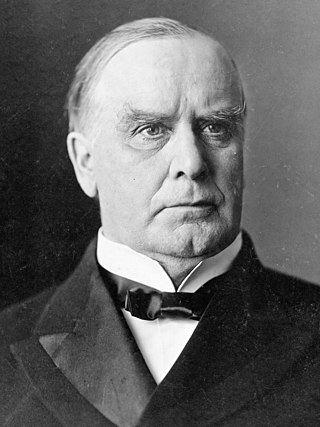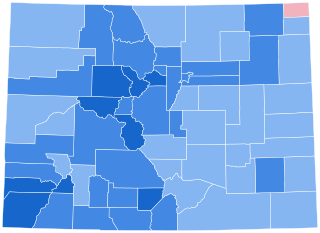
The 1896 United States presidential election was the 28th quadrennial presidential election, held on Tuesday, November 3, 1896. Former Governor William McKinley, the Republican nominee, defeated former Representative William Jennings Bryan, the Democratic nominee. The 1896 campaign, which took place during an economic depression known as the Panic of 1893, was a political realignment that ended the old Third Party System and began the Fourth Party System.

The 1900 United States presidential election was the 29th quadrennial presidential election, held on Tuesday, November 6, 1900. In a re-match of the 1896 race, incumbent Republican President William McKinley defeated his Democratic challenger, William Jennings Bryan. McKinley's victory made him the first president to win a consecutive re-election since Ulysses S. Grant accomplished the same feat in 1872. Until 1956, this would be the last time in which an incumbent Republican president would win re-election after serving a full term in office. This election saw the fifth rematch in presidential history, something that would also not occur again until 1956. This was also the first rematch to produce the same winner both times.

William Jennings Bryan was an American lawyer, orator, and politician. Beginning in 1896, he emerged as a dominant force in the Democratic Party, running three times as the party's nominee for President of the United States in the 1896, 1900, and 1908 elections. He served in the House of Representatives from 1891 to 1895 and as the Secretary of State under Woodrow Wilson from 1913 to 1915. Because of his faith in the wisdom of the common people, Bryan was often called "the Great Commoner", and because of his rhetorical power and early fame as the youngest presidential candidate, "the Boy Orator".
The Silver Republican Party, later known as the Lincoln Republican Party, was a United States political party from 1896 to 1901. It was so named because it split from the Republican Party by supporting free silver and bimetallism. The main Republican Party opposed free silver and supported the gold standard. Silver Republican strength was concentrated in the Western states where silver mining was an important industry. A leading spokesman in the House of Representatives was Willis Sweet of Idaho. Silver Republicans were elected to the Congress from several Western states. In both the 1896 and 1900 presidential elections, Silver Republicans supported Democratic presidential nominee William Jennings Bryan over Republican nominee William McKinley.

In 1896, William Jennings Bryan ran unsuccessfully for president of the United States. Bryan, a former Democratic congressman from Nebraska, gained his party's presidential nomination in July of that year after electrifying the Democratic National Convention with his Cross of Gold speech. He was defeated in the general election by the Republican candidate, former Ohio governor William McKinley.

The 1896 United States presidential election in Montana took place on November 3, 1896 as part of the 1896 United States presidential election. Voters chose three representatives, or electors to the Electoral College, who voted for president and vice president.

The 1896 United States elections elected the 55th United States Congress. Republicans won control of the Presidency and maintained control of both houses of Congress. The election marked the end of the Third Party System and the start of the Fourth Party System, as Republicans would generally dominate politics until the 1930 elections. Political scientists such as V.O. Key, Jr. argue that this election was a realigning election, while James Reichley argues against this idea on the basis that the Republican victory in this election merely continued the party's post-Civil War dominance. The election took place in the aftermath of the Panic of 1893, and featured a fierce debate between advocates of bimetallism and supporters of the gold standard.

The 1896 United States presidential election in Wisconsin was held on November 3, 1896 as part of the 1896 United States presidential election. State voters chose 12 electors to the Electoral College, who voted for president and vice president.

The 1916 United States presidential election in Wisconsin was held on November 7, 1916 as part of the 1916 United States presidential election. State voters chose 13 electors to the Electoral College, who voted for president and vice president.

The 1900 United States presidential election in Utah took place on November 6, 1900, as part of the 1900 United States presidential election held in each of the forty-five contemporary states. State voters chose three representatives, or electors to the Electoral College, who voted for president and vice president.

The 1896 United States presidential election in Utah was held on November 3, 1896 as part of the 1896 United States presidential election. Voters chose three representatives, or electors to the Electoral College, who voted for president and vice president. This was the first time Utah participated in a presidential election, having been admitted as the 45th state on January 4 of that year.

The 1896 United States presidential election in Ohio was held on November 3, 1896 as part of the 1896 United States presidential election. State voters chose 23 electors to the Electoral College, who voted for president and vice president.

The 1896 United States presidential election in Colorado took place on November 3, 1896. All contemporary 45 states were part of the 1896 United States presidential election. Voters chose four electors to the Electoral College, which selected the president and vice president.

The 1896 United States presidential election in Michigan took place on November 3, 1896. All contemporary 45 states were part of the 1896 United States presidential election. Voters chose 14 electors to the Electoral College, which selected the president and vice president.

The 1896 United States presidential election in Kentucky took place on November 3, 1896. All contemporary 45 states were part of the 1896 United States presidential election. Kentucky voters chose 13 electors to the Electoral College, which selected the president and vice president.

The 1900 United States presidential election in Colorado took place on November 6, 1900. All contemporary 45 states were part of the 1900 United States presidential election. Voters chose four electors to the Electoral College, which selected the president and vice president.

The 1900 United States presidential election in North Carolina took place on November 6, 1900. All contemporary 45 states were part of the 1900 United States presidential election. North Carolina voters chose 11 electors to the Electoral College, which selected the president and vice president.

The 1900 United States presidential election in Oregon took place on November 6, 1900. All contemporary 45 states were part of the 1900 United States presidential election. Oregon voters chose four electors to the Electoral College, which selected the president and vice president.

The 1908 United States presidential election in Oregon took place on November 3, 1908. All contemporary 46 states were part of the 1908 United States presidential election. State voters chose four electors to the Electoral College, which selected the president and vice president.

The 1916 United States presidential election in Colorado took place on November 7, 1916. All contemporary forty-eight states were part of the 1916 United States presidential election. State voters chose six electors to the Electoral College, who voted for president and vice president.






















